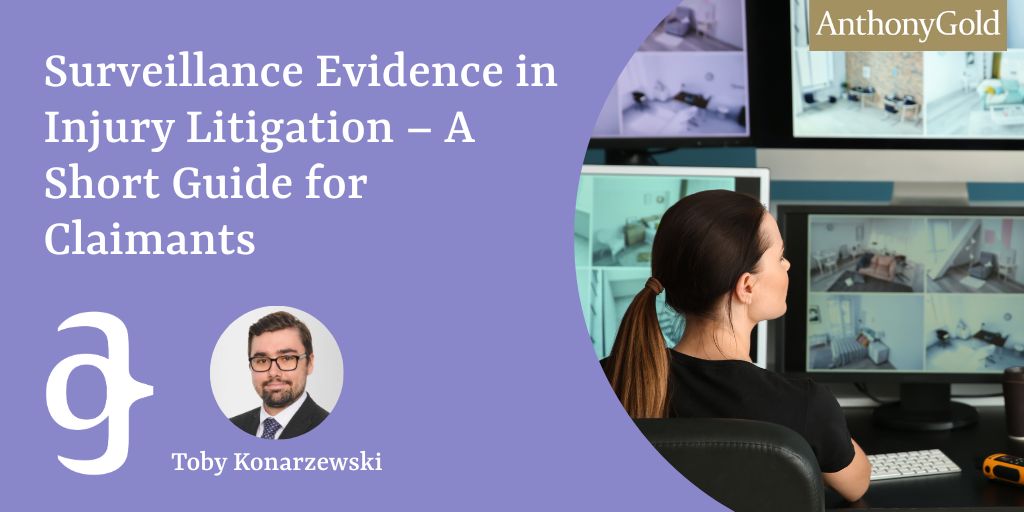Surveillance Evidence in Injury Litigation – A Short Guide for Claimants

What is surveillance evidence?
Surveillance evidence describes a category of evidence usually obtained by defendant insurance companies where a claimant may be filmed and surveyed to ensure that their claim algins with reality. The important aspect of surveillance evidence that it is covert and designed to catch-out dishonest claimants. Defendant insurance companies will often obtain this evidence when they consider that a claimant is not being entirely truthful about the nature of the injuries and losses they have suffered as a result of an accident. The use of surveillance evidence on the rise and so it is important for claimants to be aware of what it is and how it may be used against them.
How is it done?
Surveillance evidence can take many forms, although the most common example is video surveillance. Defendant insurers may arrange for recordings of the claimant outside of their home or place of work in order to evidence their day-today activities. If, for example, a dishonest claimant was seen to be driving their car after claiming they were unable to drive, the defendant’s insurers could take a video of this in order to support an allegation of fundamental dishonesty. It is not uncommon for defendant insurance companies to collect this evidence when they know the claimant will be leaving their home, such as when they are attending a defendant expert for examination or travelling to work, but evidence can be obtained whenever the claimant is in a public place.
The extensive use of social media has posed problems for all claimants due to the public nature of the content posted on websites such as Facebook, Instagram and X (formerly Twitter). Defendant insurers will often regularly review a claimant’s social media presence for anything that they consider could be used to undermine the claimant’s credibility. However, a claimant posting a picture on the beach whilst on holiday may present very differently to the reality; behind the scenes they may be struggling with the consequences of the accident, both physically and mentally. The problem is that a single picture posted on the internet rarely tells the full story. It is therefore important that claimants are given the opportunity to explain the context in which these posts were made.
Is surveillance evidence allowed?
Despite the evidence falling into a moral grey area, the short answer is yes. However, there are strict rules of evidence that defendant insurance companies wishing to use this evidence must follow. By failing to follow these rules, defendant insurers risk having their surveillance evidence being withdrawn from the proceedings by the Court. The aim of these rules is to balance the playing field for honest claimants that may be taken out of context by giving them an opportunity to explain the evidence, and to act as a deterrent for defendant insurers abusing the evidential processes.
If a defendant insurance company wishes to rely upon surveillance evidence as part of their case, it must be disclosed at the earliest opportunity. However, defendant insurance companies have a track record of ambushing claimants with surveillance evidence in the weeks before Trial in an attempt to catch them off guard. But in a recent case, the defendant insurer was heavily criticised for trying to bend the rules of disclosure in order to get away with an evidential ambush involving surveillance evidence (Axa Insurance UK PLC v Kryeziu & Ors [2023] EWHC 3233 (KB).
Defendant insurers will often attempt limit the surveillance evidence they provide to fit their narrative. However, defendant insurance companies must provide all the surveillance evidence that they wish to rely upon, not just excerpts or clips that support their position. This may be the entirety of any surveillance footage (which may be many hours long), or to include the comment sections or captions of social media posts. This is important as it enables the claimants to comment upon the wider context in which the evidence exists. It will also enable medical experts to comment upon whether the evidence is commensurate to the extent and severity of the claimant’s alleged injuries.
Conclusions
Whilst surveillance evidence is a morally ambiguous practice, genuine and honest claimants have nothing to worry about. The purpose of this evidence is to catch-out those brining dishonest claims which ultimately benefits the wider public with (supposedly) lower insurance premiums. That being said, the extent to which defendant insurance companies are using surveillance evidence seems to be expanding and they are often more than willing to discredit a genuine claimant, whether that be for part or all of their claim.
* Disclaimer: The information on the Anthony Gold website is for general information only and reflects the position at the date of publication. It does not constitute legal advice and should not be treated as such. It is provided without any representations or warranties, express or implied.*
No comments